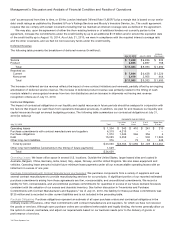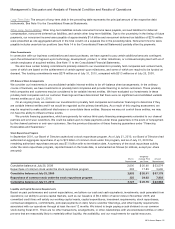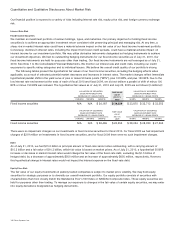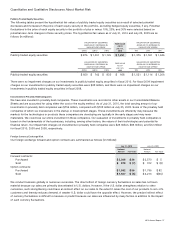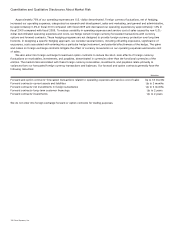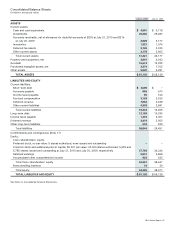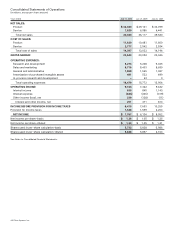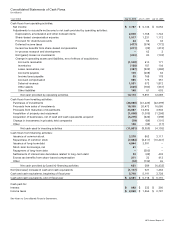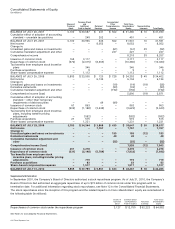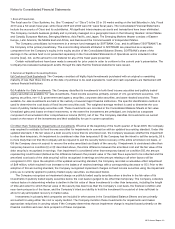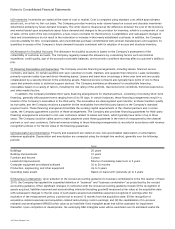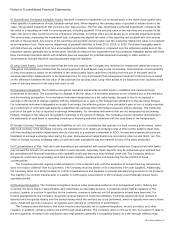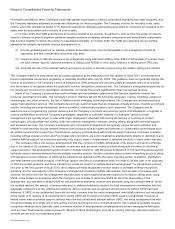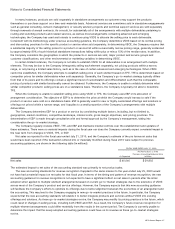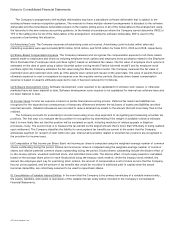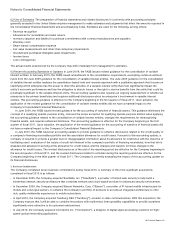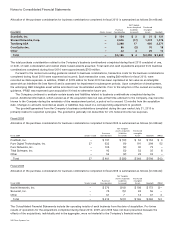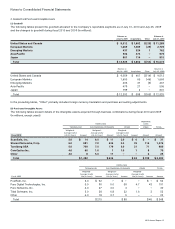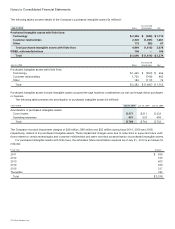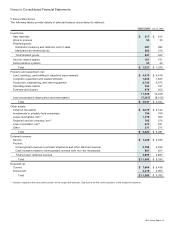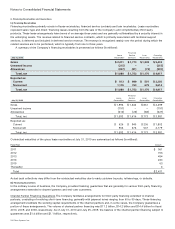Cisco 2010 Annual Report Download - page 46
Download and view the complete annual report
Please find page 46 of the 2010 Cisco annual report below. You can navigate through the pages in the report by either clicking on the pages listed below, or by using the keyword search tool below to find specific information within the annual report.
Notes to Consolidated Financial Statements
(d) Inventories Inventories are stated at the lower of cost or market. Cost is computed using standard cost, which approximates
actual cost, on a first-in, first-out basis. The Company provides inventory write-downs based on excess and obsolete inventories
determined primarily by future demand forecasts. The write-down is measured as the difference between the cost of the inventory
and market based upon assumptions about future demand and charged to the provision for inventory, which is a component of cost
of sales. At the point of the loss recognition, a new, lower cost basis for that inventory is established, and subsequent changes in
facts and circumstances do not result in the restoration or increase in that newly established cost basis. In addition, the Company
records a liability for firm, noncancelable, and unconditional purchase commitments with contract manufacturers and suppliers for
quantities in excess of the Company’s future demand forecasts consistent with its valuation of excess and obsolete inventory.
(e) Allowance for Doubtful Accounts The allowance for doubtful accounts is based on the Company’s assessment of the
collectibility of customer accounts. The Company regularly reviews the allowance by considering factors such as historical
experience, credit quality, age of the accounts receivable balances, and economic conditions that may affect a customer’s ability to
pay.
(f) Financing Receivables and Guarantees The Company provides financing arrangements, including leases, financed service
contracts, and loans, for certain qualified end-user customers to build, maintain, and upgrade their networks. Lease receivables
primarily represent sales-type and direct-financing leases. Leases and loans have on average a three-year term and are usually
collateralized by a security interest in the underlying assets. Financed service contracts also typically have terms of one to three
years and primarily relate to technical support services. The Company maintains an allowance for uncollectible financing
receivables based on a variety of factors, including the risk rating of the portfolio, macroeconomic conditions, historical experience,
and other market factors.
In addition, the Company facilitates third-party financing arrangements for channel partners, consisting of revolving short-term
financing, generally with payment terms ranging from 60 to 90 days. In certain instances, these financing arrangements result in a
transfer of the Company’s receivables to the third party. The receivables are derecognized upon transfer, as these transfers qualify
as true sales, and the Company receives a payment for the receivables from the third party based on the Company’s standard
payment terms. These financing arrangements facilitate the working capital requirements of the channel partners and, in some
cases, the Company guarantees a portion of these arrangements. The Company also provides financing guarantees for third-party
financing arrangements extended to end-user customers related to leases and loans, which typically have terms of up to three
years. The Company could be called upon to make payments under these guarantees in the event of nonpayment by the channel
partners or end-user customers. Deferred revenue relating to these financing arrangements is recorded in accordance with revenue
recognition policies or for the fair value of the financing guarantees.
(g) Depreciation and Amortization Property and equipment are stated at cost, less accumulated depreciation or amortization,
whenever applicable. Depreciation and amortization are computed using the straight-line method, generally over the following
periods:
Period
Buildings 25 years
Building improvements 10 years
Furniture and fixtures 5 years
Leasehold improvements Shorter of remaining lease term or 5 years
Computer equipment and related software 30 to 36 months
Production, engineering, and other equipment Up to 5 years
Operating lease assets Based on lease term—generally up to 3 years
(h) Business Combinations Upon adoption of the revised accounting guidance for business combinations in the first quarter of fiscal
2010, the Company has applied the expanded definition of “business” and “business combination” as prescribed by the revised
accounting guidance. Other significant changes in connection with the revised accounting guidance include (i) the recognition of
assets acquired, liabilities assumed and noncontrolling interests (including goodwill) measured at fair value at the acquisition date
with subsequent changes to the fair value of such assets acquired and liabilities assumed recognized in earnings after the
expiration of the measurement period, a period not to exceed 12 months from the acquisition date; (ii) the recognition of
acquisition-related expenses and acquisition-related restructuring costs in earnings; and (iii) the capitalization of in-process
research and development (IPR&D) at fair value as an indefinite-lived intangible asset that will be assessed for impairment
thereafter. Upon completion of development, the underlying R&D intangible asset will be amortized over its estimated useful life.
44 Cisco Systems, Inc.


